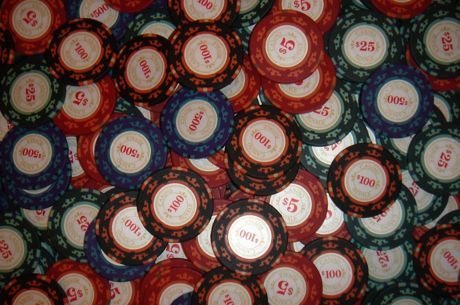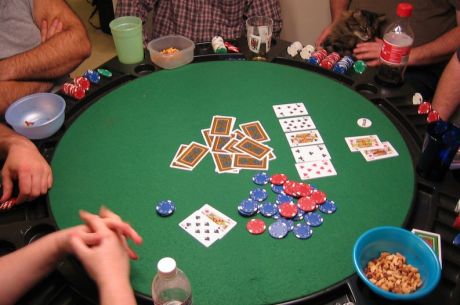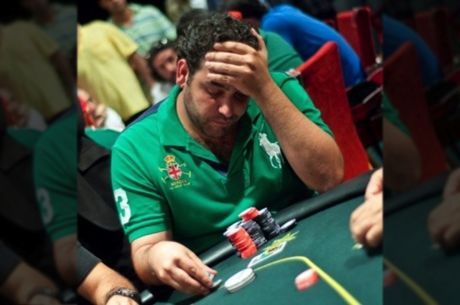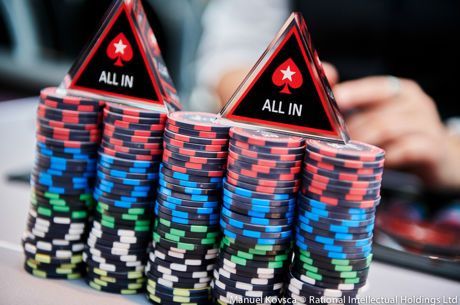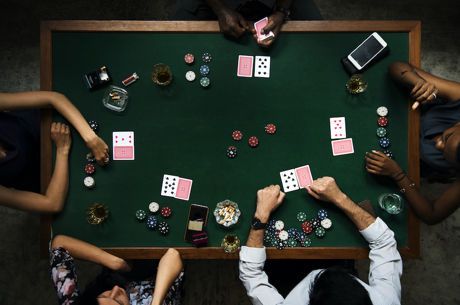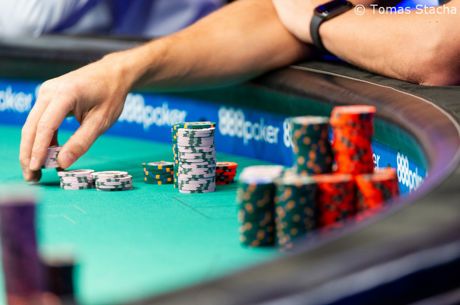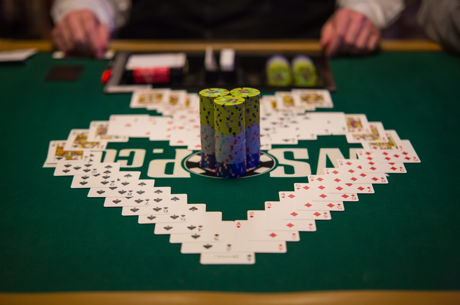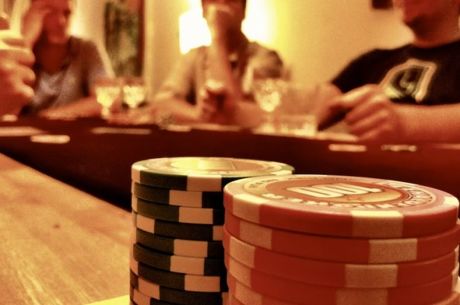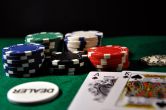Hosting an Awesome Poker Game at Home: The Poker Table
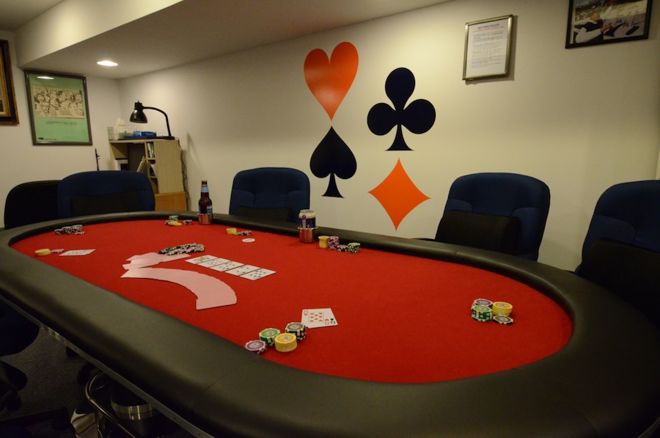
As many of our poker experiences have grown to include casinos and dedicated poker rooms, so, too, have our expectations grown for our own personal poker environment.
In the old days, poker was played on anything, anywhere. I've played on kitchen tables, an ottoman, a park bench, a counter in a diner, and the back seat of my car. I've even played right on the ground, outside, with three guys huddled around in a circle during a snowstorm. (We were waiting to be picked up from college — dealing was hard with gloves on.)
Things have changed. Today when we go to home games, we often expect to play at an actual, dedicated poker table. Here are some thoughts about how to acquire the right poker table for you — and what to budget.
PokerNews Top Five Poker Tables to Buy
| Rank | Brand | Value | Quality | Our Rating | Buy on Amazon |
| 1 | vidaXL Blue 10-Player Professional Poker Table | ***** | ***** | ***** | Buy Now |
|---|---|---|---|---|---|
| 2 | RAYKEEP 71 Inch Poker Table Foldable | ***** | **** | ***** | Buy Now |
| 3 | JeeKoudy 48 Inch Folding Round Poker Table | **** | **** | **** | Buy Now |
| 4 | 9-Player Folding Poker Table 3 Fold Oval Green | **** | **** | **** | Buy Now |
| 5 | 78 Inch Tri-fold Texas Holdem Poker Table Top | **** | **** | *** | Buy Now |
The Poker Table: Different Types for Different Budgets
Just as players can play poker at whatever stakes they prefer, poker tables exist for every budget imaginable.
You can buy something as cheap as a folding table top that will fit on top of any existing table — they come new for as little as $40-$70. You can even get them more cheaply by checking out used ones on eBay or Craigslist.
Poker is one of those hobbies that attract people's interest for a brief period of time, and when that interest fades, they still have tables, chip sets, cards, and the like. If they can recover any of the money they lost playing poker by selling any of these poker-related items, they think of it as a godsend. So expect great deals in used equipment. (Sometimes people even give them away.)
One step up from the table top is an actual table that folds up. At the lowest end of the scale there are some cheaply made ones (usually from China) that you can get for about $150. But these look really cheap, with the fold marks completely visible even when the stiff cardboard table is fully open. There is often also some warp in the table and unsteadiness in the thin, cheaply attached folding legs.
Better would be a wooden eight-sided poker table, with folding legs, a vinyl or felt table top, surrounded by an "apron" with cup holders. Such a table is, I think, the minimum quality for any regular poker game not being run by a high school or college student. I bought mine in 1994 for $150 or so, and after two-plus decades of frequent use it is still perfectly serviceable. You can still find them in specialty stores and online for around $200.
One downside to this table is that it really doesn't accommodate the nine or ten players you'd want for a casino-like full ring hold'em game or tournament. That has rarely bothered me, because I had a regular group who liked to play stud and draw, which meant the game rarely topped eight players. But if you want what you see in a casino, you'll have to go with the oval table.
The best rule of thumb that I can apply is that when it comes to poker tables, you tend to get what you pay for. The cheapest oval tables are what I described earlier, and can be purchased for about $150. One step up are firmer but still pretty cheap-looking tables for $275 to $350.
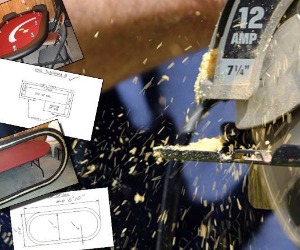
You can build your DIY poker table with just some plywood, foam, and felt. But it's not as easy as that; there's more to it. Building your own poker table encompasses a lot, so read this before you get going, as we bring you the do-it-yourself guide to building your own poker table.
Play NowThe table that I recommend as a permanent addition to your poker room starts at about $500-$600. These have firm, flat, and level wooden bases, nice felt, a vinyl- or leather-trimmed cushion, and solidly applied, sturdy folding legs underneath. You can also add features that make the table even nicer, depending on your tastes, including built-in cup holders, a cutout space for a dealer and chip tray, and custom felt and felt designs.
I had my table made by a local pub league company that also makes home-use tables. With all the bells and whistles, including delivery and a money-back guarantee, mine cost about $700 a couple of years ago. It seemed like a lot at the time, but if you figure it's going to last you for many hundreds of poker sessions, it comes to only a few bucks a game. In my opinion, it's well worth it.
The Poker Table: Covering the Bases
The next item to consider is the base. Are you looking for something that can be moved in and out of a room — or even to someone else's house from time to time? If so, then you want folding legs. On the other hand, if you have a dedicated den or poker room and plan to make the poker table a permanent fixture, then you should get the pedestal base. It's nicer, sturdier, and makes the table look more impressive and imposing. This latter option will probably run you another $100-$200 or so.
There are many more expensive options as well. Once your table is viewed as a permanent piece of furniture, the sky is the limit, as all sorts of woods, finishes, and handcrafted designs come into play. Some can double as a beautiful dining room table, by either adding an optional cover that serves as a table top. One model even has a swiveling table top — a dining table on one side and the other an eight-segmented poker table, complete with a depression for chips and a cup holder. Those types of table will cost you between $700 and $2,000.
Of course, you can spend a lot more for a table as well. You can go online and find absolutely beautiful poker tables for $5,000 and up. I've even seen one that is encrusted with jewels and sells for $20,000.
One other consideration that no one envisioned until recently is whether you want to consider using your table for taping a poker show. There are now tables built with card cameras, electric hook-ups, and even phone-charging stations. As you might imagine, these options aren't inexpensive. You can have a table with them for a few thousand.
Finally, for those of you who are even a little bit handy, you might want to consider buying some plans for a table and then building it yourself. The materials are very simple and inexpensive. I've spoken to many people who say that it really isn't difficult to cut the wood, add the felt, put on the foam filled apron including cup holders, and then attach the legs. They said it took them only about four hours (not counting the time to let dry the adhesive used for the felt and cushions), with the total cost for materials only about $85. Plans are available for purchase for $45 or so — and you get to build it exactly as you want it.
The Poker Table: Other Considerations
There are a few other considerations when shopping for a poker table. For one, you need to think about where you're going to put it. Ideally, you want to make sure you hadhaveroom for some nicely padded, reclining, wheeled, and adjustable poker chairs and small tables for food and drinks.
You also want to make sure that there is excellent lighting. I recommend track lighting that gives you the ability to move high intensity lights around the ceiling to accommodate different tables you might have in the room at different times. I also have a nice central light fixture to illuminate the entire room and to eliminate many of the shadows that high intensity lights can cast.
To complete the room, make sure there is good temperature control, plenty of places for people to plug in their phones and other electronic devices, perhaps a refrigerator with a freezer for beverages and ice, a microwave for heating up food, and a full liquor cabinet. You'll also want to make sure you have some televisions mounted on the walls for the players who need to be distracted in between hands.
Put it all together, and you've got a great poker room.
Addendum: A professional poker table manufacturer has disputed my estimate of the price of building your own table, pointing out correctly, I now believe, that it costs much more for someone to build his table than I estimated. You can find his response on my personal blog.
Also in this series...
- Hosting an Awesome Poker Game at Home: Who to Invite
- Hosting an Awesome Poker Game at Home: Poker Chips
- Hosting an Awesome Poker Game at Home: Tournaments vs. Cash Games
- Hosting an Awesome Poker Game at Home: Playing Cards
- Hosting an Awesome Poker Game at Home: Drinks and Snacks
Ashley Adams has been playing poker for 50 years and writing about it since 2000. He is the author of hundreds of articles and two books, Winning 7-Card Stud (Kensington 2003) and Winning No-Limit Hold'em (Lighthouse 2012). He is also the host of poker radio show House of Cards. See www.houseofcardsradio.com for broadcast times, stations, and podcasts.
Photo: Poker Table, slgckgc, CC BY-2.0.
Want to stay atop all the latest in the poker world? If so, make sure to get PokerNews updates on your social media outlets. Follow us on Twitter and find us on both Facebook and Google+!
In this Series
- 1 Hosting an Awesome Poker Game at Home: The Poker Table
- 2 Hosting an Awesome Poker Game at Home: Who to Invite
- 3 Best Poker Chips: Top Poker Chip Sets for Home Games
- 4 Hosting an Awesome Poker Game at Home: Tournaments vs. Cash Games
- 5 Hosting an Awesome Poker Game at Home: Playing Cards
- 6 Hosting an Awesome Poker Game at Home: Drinks and Snacks

